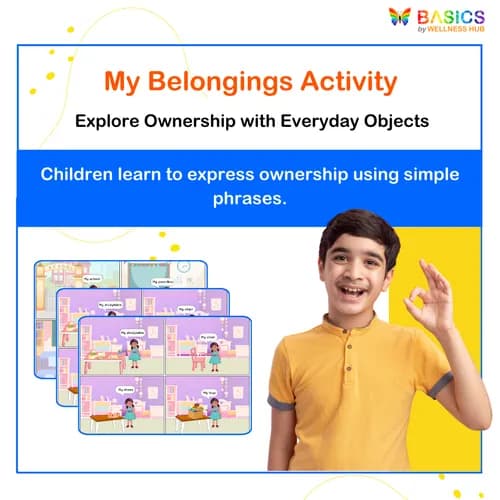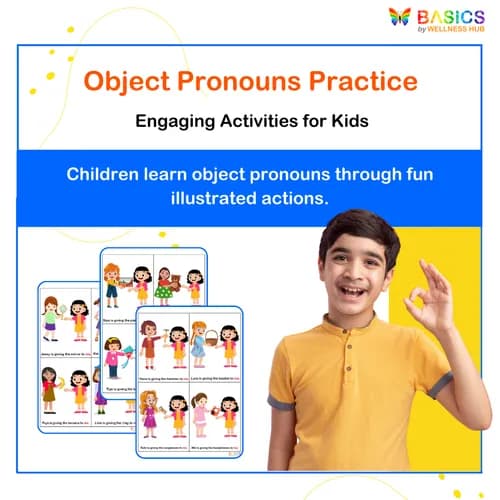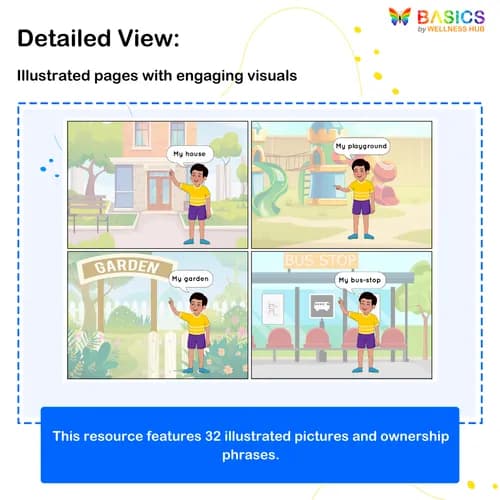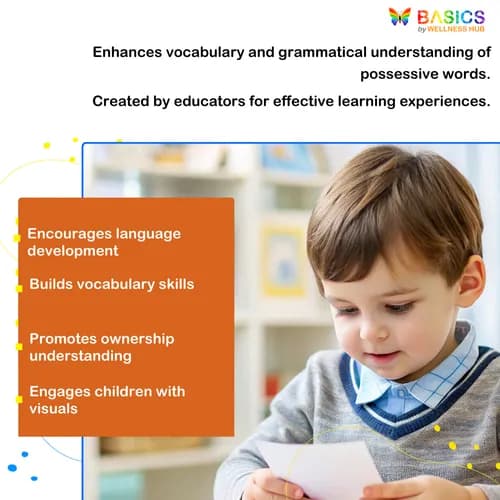





INDIAN BOY: Learn “My” with Everyday Objects – Printable PDF
₹80
₹160
50% off
0 (0 ratings)
Grade Levels
Pre-K - Grade 1 (Ages 3-6)
Content Overview
Format: Printable PDF, Total Pages: 8, Features: 32 illustrated pictures teaching possession with 'My' phrases.
Categories
Pages from the Resource
Help children learn possession with the INDIAN BOY: Learn “My” with Everyday Objects PDF. This engaging resource features 32 illustrated pictures of an Indian boy with familiar items, teaching kids to express ownership through simple phrases like “My shoes” and “My school.” Perfect for expanding vocabulary and understanding possessive words.

Page 1

Page 2
What Users Say
0
0 ratings
5
0+
4
0+
3
0+
2
0+
1
0+
5 Stars
Product is Good to use.
1 year ago
Varsha Parent
Similar Products

INDIAN GIRL: Learn “My” with Everyday Objects – Printable PDF
₹ 80.00
₹ 160.00
50% off
5.0 (56 ratings)

Conjunctions: Learn to Connect Words with 'And' – Printable PDF
₹ 80.00
₹ 160.00
50% off
4.8 (48 ratings)

IS / ARE – With Colors: Printable PDF for Learning Singular and Plural
₹ 80.00
₹ 160.00
50% off
4.8 (48 ratings)

Printable Sentences Using 'I' with Actions and Objects PDF for Kids
₹ 80.00
₹ 160.00
50% off
4.7 (52 ratings)

Object Pronouns: She (Giving to Me) – Printable PDF for Kids
₹ 80.00
₹ 160.00
50% off
5.0 (56 ratings)
About the Product
Introduction
Understanding possession is a fundamental aspect of language development for young children. The INDIAN BOY: Learn "My" with Everyday Objects printable PDF is designed to help children aged 3-6 grasp the concept of ownership through engaging visuals and simple phrases. Featuring an Indian boy character, this resource presents familiar items, people, and places that children can relate to, making the learning process both enjoyable and meaningful.
With 8 pages of vibrant illustrations, each page showcases 4 pictures where the boy identifies his belongings using phrases like "My shoes" and "My bag." This interactive approach not only enhances vocabulary but also reinforces grammatical understanding of possessive words, encouraging children to express ownership confidently. Ideal for use at home, in preschool settings, or during therapy sessions, this resource supports early literacy skills in a fun and engaging way.
Product Details
- Product Name: INDIAN BOY: Learn "My" with Everyday Objects
- Format: Printable PDF
- Total Pages: 8
- Illustrated Pictures: 32 (4 pictures per page)
- Content: Each picture features the boy with one item or relation, using the phrase "My …"
- Example Phrases: My shoes, My shirt, My cap, My toy, My book, My school, My father, My bag
- Visuals: Colorful, child-friendly illustrations depicting an Indian boy with personal belongings
- Designed For: Early childhood education, language development, and vocabulary building
- Best Suited For: Ages 3-6, suitable for home, classroom, and therapy use
Educational Benefits
1. Enhances Vocabulary Acquisition
- Introduces children to everyday objects and relationships, expanding their vocabulary.
- Encourages the use of possessive phrases, helping children articulate ownership clearly.
2. Supports Grammatical Understanding
- Teaches the concept of possession through simple phrases, reinforcing grammatical structures.
- Helps children understand how to use "My" correctly in different contexts.
3. Promotes Language Development
- Encourages verbal expression as children practice saying phrases aloud.
- Supports early literacy skills by connecting words with visual representations.
4. Engages Visual Learners
- Utilizes colorful illustrations to capture children's attention and enhance learning.
- Visual aids make it easier for children to remember and associate words with objects.
5. Fosters Cultural Awareness
- Features an Indian boy character, promoting diversity and cultural representation in learning materials.
- Helps children relate to the content, making learning more meaningful and engaging.
Instructions for Use
Step 1: Preparation
- Download and print the PDF resource on standard A4 or Letter-sized paper.
- Ensure you have enough copies for each child if using in a group setting.
Step 2: Introduction to Possession
- Begin by explaining the concept of possession using simple language.
- Show the child a few examples of items in the room and ask, "Whose is this?" to engage them in the topic.
Step 3: Picture Exploration
- Go through each page together, pointing to the illustrations and reading the phrases aloud.
- Encourage the child to repeat the phrases after you, reinforcing pronunciation and confidence.
Step 4: Interactive Practice
- Ask the child to identify their own belongings using the phrase "My…"
- For example, prompt them with "What is your favorite toy?" and guide them to respond with "My toy."
Step 5: Role-Playing Activity
- Create a fun role-playing scenario where the child can use the phrases in context.
- For example, pretend to pack a bag and ask, "What's in your bag?" to encourage them to respond with "My book" or "My cap."
Step 6: Reinforcement Through Games
- Incorporate games such as matching cards or a scavenger hunt where children find items and say "My…" for each one they find.
- Use positive reinforcement to celebrate their efforts and correct usage.
Step 7: Review and Repeat
- Regularly revisit the resource to reinforce learning and build confidence.
- Encourage children to use the phrases in everyday conversations to solidify their understanding of ownership.
Activities Using the Resource
1. Picture Identification Game
Objective: Reinforce vocabulary and ownership recognition.
How to Play:
- Show a page with illustrations and phrases.
- Ask the child to point to each item and say, "My shoes," "My book," etc.
- Encourage them to explain why each item is theirs.
Skill Development:
- Vocabulary reinforcement
- Expressive language skills
- Confidence in ownership expression
2. My Belongings Show and Tell
Objective: Encourage personal connection to the concept of possession.
How to Play:
- Have the child gather 3-5 of their own items.
- Prompt them to present each item using "My…" (e.g., "My toy car").
- Discuss why each item is special to them.
Skill Development:
- Public speaking
- Personal expression
- Vocabulary application
3. Memory Match Game
Objective: Enhance memory skills and reinforce vocabulary.
How to Play:
- Create pairs of cards with illustrations and phrases (e.g., one card with a picture of a bag and another with "My bag").
- Place cards face down and take turns flipping to find matches.
- When a match is found, say the phrase aloud.
Skill Development:
- Memory retention
- Visual discrimination
- Turn-taking skills
4. Ownership Role Play
Objective: Practice possessive phrases in real-life contexts.
How to Play:
- Set up a pretend play scenario (e.g., a store or a picnic).
- Encourage the child to use phrases like "My sandwich" or "My hat" as they interact with items in the scenario.
- Role-play different situations to reinforce usage.
Skill Development:
- Practical language use
- Imaginative play
- Social interaction skills
5. Scavenger Hunt for My Items
Objective: Connect learning to the real world through exploration.
How to Play:
- Create a list of items for the child to find around the house (e.g., "Find your shoes").
- As they locate each item, prompt them to say, "My…" followed by the item name.
- Celebrate each find with excitement!
Skill Development:
- Active engagement
- Vocabulary application
- Physical coordination
6. Create Your Own "My" Book
Objective: Foster creativity and personal ownership expression.
How to Play:
- Provide blank pages for the child to draw or paste pictures of their belongings.
- Help them write phrases like "My bike" or "My favorite book" under each picture.
- Bind the pages together to create a personalized book.
Skill Development:
- Creative expression
- Writing skills
- Understanding of ownership
Frequently Asked Questions
Q1: What age group is this resource designed for?
A1: This resource is specifically designed for children aged 3-6 years. It provides a fun and engaging way for young learners to grasp the concept of possession through relatable visuals and simple phrases, making it ideal for early childhood education settings. The illustrations and phrases are tailored to resonate with young children, ensuring they can easily connect with the material.
Q2: How can I use this resource in a group setting?
A2: In a group setting, you can print multiple copies of the PDF and have children work in pairs or small groups. They can take turns identifying items, practicing the phrases, and engaging in interactive activities like "Show and Tell" to reinforce their understanding of ownership. This collaborative approach not only enhances learning but also encourages social interaction and communication among peers.
Q3: Can this resource be used for children with special needs?
A3: Yes, this resource is designed to be inclusive and can be adapted for children with special needs. The clear visuals and simple language make it accessible for various learning styles. Additionally, you can modify activities to suit individual needs, such as using tactile objects or providing additional support during group interactions to ensure every child can participate and benefit.
Q4: How do I print or laminate the resource for durability?
A4: The PDF is designed for easy printing, and you can print it on standard letter-sized paper. For added durability, consider laminating the pages after printing. This will not only protect the resource from wear and tear but also allow for repeated use in various settings, such as classrooms or therapy sessions, where children can use dry-erase markers to interact with the material.
Q5: What is your refund policy if I am not satisfied with the resource?
A5: Wellness Hub offers a satisfaction guarantee. If you are not satisfied with your purchase, you can request a refund within 30 days of purchase. Please contact our support team with your order details, and they will assist you with the process. We believe in the quality of our resources and want to ensure you have a positive experience.
Q6: How do I access support if I have questions about the resource?
A6: If you have any questions or need assistance, you can reach out to our support team via the contact form on our website. We aim to respond to all inquiries within 24-48 hours to ensure you have the help you need. Our team is dedicated to providing you with the best support possible to enhance your experience with our resources.
Q7: What types of resources does Wellness Hub offer?
A7: Wellness Hub provides a wide range of resources, including expert-led therapy sessions, home therapy materials like flashcards and worksheets, and visual schedules. Our goal is to support parents and caregivers in continuing their child's progress at home, ensuring that they have access to high-quality materials that align with therapeutic goals.
Q8: Is there a bulk licensing option for schools or organizations?
A8: Yes, Wellness Hub offers bulk licensing options for schools and organizations. This allows you to purchase multiple copies of resources at a discounted rate, making it easier to implement our materials in classrooms or therapy settings. For more information on pricing and licensing agreements, please contact our support team.
Q9: How are the resources delivered after purchase?
A9: After completing your purchase, you will receive an email with a download link for the PDF resource. The process is straightforward, and you can access your materials immediately. If you encounter any issues with the download, our support team is available to assist you promptly.
Q10: Are the resources accessible for individuals with disabilities?
A10: Yes, we strive to make our resources accessible for individuals with disabilities. The PDF files are designed to be compatible with screen readers, and we use clear visuals and simple language to accommodate various learning needs. If you have specific accessibility requirements, please reach out to our support team for tailored assistance.
Usage Rights and Restrictions
Allowed Usage:
- Personal use by parents, teachers, and therapists.
- Printable for classroom, home, or therapy settings.
- Can be used in group or one-on-one learning sessions.
Not Allowed:
- Reselling, redistributing, or modifying the resource for commercial use.
- Sharing publicly (e.g., on blogs, social media, or websites) without permission.
- Uploading the file to public sharing platforms.
If you need a bulk license for schools or therapy centers, please contact us.
Conclusion
The INDIAN BOY: Learn "My" with Everyday Objects printable PDF is an essential resource for young children to grasp the concept of possession in a fun and relatable way. With its vibrant illustrations and simple phrases, this 8-page resource is designed for children aged 3-6, making it perfect for home, classroom, or therapy use. By engaging with the content, children will enhance their vocabulary, improve their grammatical understanding, and confidently express ownership through everyday language.
This resource not only supports language development but also fosters cultural awareness by featuring an Indian boy character, allowing children to connect with the material on a personal level. Download this engaging PDF today and empower your child to express themselves with clarity and confidence!



